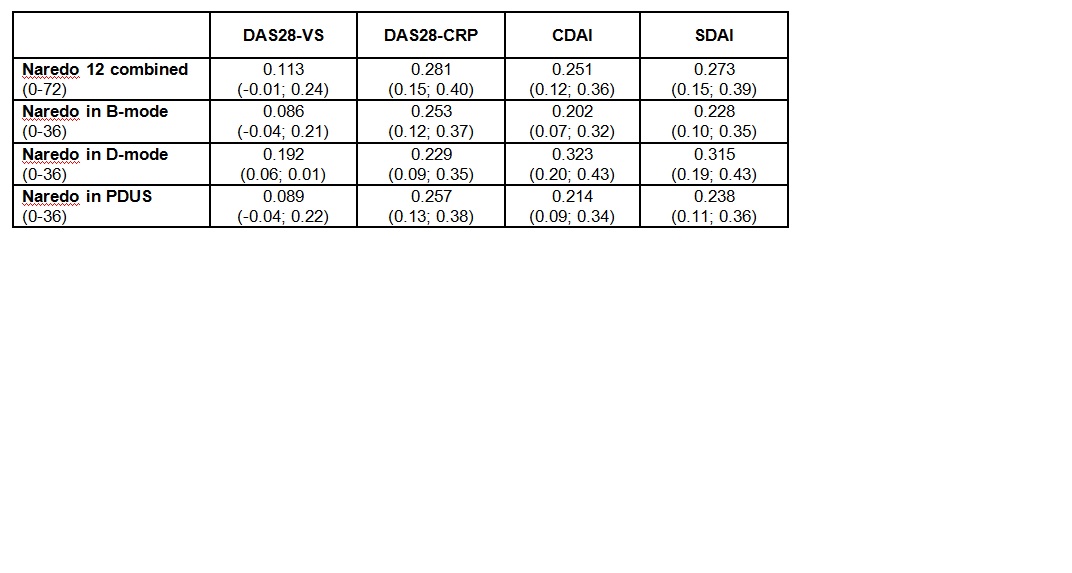Session Information
Date: Sunday, November 13, 2016
Title: Imaging of Rheumatic Diseases - Poster I: Ultrasound and Emerging Technologies
Session Type: ACR Poster Session A
Session Time: 9:00AM-11:00AM
Background/Purpose: Clinical remission is now a realistic goal in managing rheumatoid arthritis (RA) with treat to target strategy assessed according to different composite scores (DAS28, Simplified Disease Activity Index (SDAI), Clinical Disease Activity Index (CDAI), ACR-EULAR 2011 for remission). There are, however, no validated ultrasound remission criteria because of continuing uncertainty on the signification of persistent synovial hypertrophy in B-mode or Power Doppler (PD) mode in RA patients in clinical remission. Objective: evaluate correlations between the validated 12 joints-Naredo ultrasound score (B-mode (0-3), PD (0-3), combined B+PD (0-6) or PDUS (0-3, max between B-mode or PD)) and the DAS28-ESR, DAS28-CRP, CDAI, SDAI and ACR-EULAR criteria for remission in routine care.
Methods: French multicenter cross-sectional study in 11 rheumatology departments. The inter and intra-observer reproducibility for the ultrasound scoring was good to excellent. Inclusion criteria were as follows: RA meeting ACR-EULAR criteria, <15 years of progression, DAS-28-ESR<2.6 for at least 3 months, with a stable treatment including corticoids if necessary (equivalent prednisone<0.1 mg/kg) for 6 months. A standardized US examination was performed by an experience ultrasonographist blinded to clinical data. Spearman’s correlation coefficients were determined between the Naredo12 B-mode (min-max,0-36), PD mode (0-36), combined mode (0-72) and PDUS (0-36) scores and the different clinical remission scores. The impact of disease duration or duration of the clinical remission on ultrasound scores was also assessed (Kruskall-Wallis’s test).
Results: 225 patients were included consecutively (58.6±12.4 years, 68.4% women, RA duration 6±3.7ans, 71.3% ACPA+, duration of remission 20.8±19.4 months, 92% on methotrexate, 52.4% on biotherapy, 9.8% on corticoids, DAS28-ESR=1.7, 75% in ACR-EULAR remission). 68.9% of patients had a PD Naredo score of 0, 82.7% ≤ 1, 90.7%≤2. Table 1 presents correlations between ultrasound scores and clinical scores. These correlations were weak to moderate, depending on the set of criteria. No association was found between ultrasounds scores and duration of the remission or of the disease.
Conclusion: The Naredo score in PD mode showed the best construct validity whatever the clinical score chosen, even though the correlations remained relatively weak, in part because of differences between the joints analyzed (12 US joints including ankles vs. 28 clinical joints without ankles). The CDAI and SDAI, which are more stringent for clinical remission appeared to correlate better than the DAS28-ESR score which is the most widely used in everyday practice. Other real–life studies are necessary to evaluate the potential added value of this combined US-clinical assessment of RA remission in routine care.
To cite this abstract in AMA style:
Cugnet M, Trabelsi M, Ornetti P, Gaudin P, Rouanet S, Baillet A. Agreement Between DAS28-ESR, DAS28-CRP, SDAI, CDAI (Simplified/Clinical Disease Activity Index), ACR/EULAR Remission Criteria and Ultrasound Scoring (Naredo-12) in Patients with Rheumatoid Arthritis in Routine Care [abstract]. Arthritis Rheumatol. 2016; 68 (suppl 10). https://acrabstracts.org/abstract/agreement-between-das28-esr-das28-crp-sdai-cdai-simplifiedclinical-disease-activity-index-acreular-remission-criteria-and-ultrasound-scoring-naredo-12-in-patients-with-rheumatoid-arthritis-i/. Accessed .« Back to 2016 ACR/ARHP Annual Meeting
ACR Meeting Abstracts - https://acrabstracts.org/abstract/agreement-between-das28-esr-das28-crp-sdai-cdai-simplifiedclinical-disease-activity-index-acreular-remission-criteria-and-ultrasound-scoring-naredo-12-in-patients-with-rheumatoid-arthritis-i/

